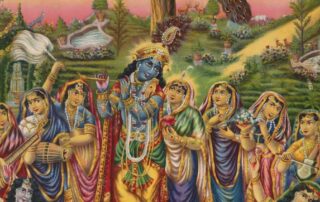Latest Posts
Here you will find all the latest posts on the Bhaktivinoda Institute in the form of Articles, Book Chapters, Songs & Poems etc.
Śrīla Bhaktivinoda Ṭhākura Viraha-guṇa-gāna
Śrīla Bhaktivinoda Ṭhākura Viraha-guṇa-gāna by Anonymous (kothā) bhakativinoda śrī-gaura-svajana! kṛṣṇa-prema dite, esechile martye mānavera sāje karuṇā-kāraṇa (1) O Śrīla Bhaktivinoda Ṭhākura, personal associate Read More...
The Appearance Day of Śrīla Bhaktivinoda Ṭhākura
The Appearance Day of Śrīla Bhaktivinoda Ṭhākura by Śrīla A.C. Bhaktivedānta Swami Prabhupāda From a lecture given in London on 3rd September 1971 Read More...
Ātma-Nivedana Song Eight
Śaraṇāgati (Surrendered to the Lord's Shelter) Second Principle of Surrender: Ātma-Nivedana (Dedication of the Self) - Song 8 (1) ātma-nivedana, tuwā pade kori', hoinu Read More...
Ātma-Nivedana Song Seven
Śaraṇāgati (Surrendered to the Lord's Shelter) Second Principle of Surrender: Ātma-Nivedana (Dedication of the Self) - Song 7 (1) nivedana kori prabhu! tomāra caraṇe Read More...
Ātma-Nivedana Song Six
Śaraṇāgati (Surrendered to the Lord's Shelter) Second Principle of Surrender: Ātma-Nivedana (Dedication of the Self) - Song 6 (1) bastutaḥ sakali tava, jīva keho Read More...
Ātma-Nivedana Song Five
Śaraṇāgati (Surrendered to the Lord's Shelter) Second Principle of Surrender: Ātma-Nivedana (Dedication of the Self) - Song 5 (1) 'āmāra' bolite prabhu! āre kichu Read More...
Ātma-Nivedana Song Four
Śaraṇāgati (Surrendered to the Lord's Shelter) Second Principle of Surrender: Ātma-Nivedana (Dedication of the Self) - Song 4 (1) 'ahaṁ mama'-śabda-arthe jāhā kichu hoy Read More...
Ātma-Nivedana Song Three
Śaraṇāgati (Surrendered to the Lord's Shelter) Second Principle of Surrender: Ātma-Nivedana (Dedication of the Self) - Song 3 (1) mānasa, deho, geho, jo kichu Read More...
Ātma-Nivedana Song Two
Śaraṇāgati (Surrendered to the Lord's Shelter) Second Principle of Surrender: Ātma-Nivedana (Dedication of the Self) - Song 2 (1) (prāneśwar!) kohobuṅ ki sarama ki Read More...
Ātma-Nivedana Song One
Śaraṇāgati (Surrendered to the Lord's Shelter) Second Principle of Surrender: Ātma-Nivedana (Dedication of the Self) - Song 1 (1) nā koroluṅ karama, geyāna nāhi Read More...
Dainya Song Seven
Śaraṇāgati (Surrendered to the Lord's Shelter) First Principle of Surrender: Dainya (humility) - Song 7 (1) (prabhu he!) emona durmati, saṁsāra bhitore, poḍiyā āchinu Read More...
Dainya Song Six
Śaraṇāgati (Surrendered to the Lord's Shelter) First Principle of Surrender: Dainya (humility) - Song 6 (1) (prabhu he!) tuwā pade e minati mor tuwā Read More...
Dainya Song Five
Śaraṇāgati (Surrendered to the Lord's Shelter) First Principle of Surrender: Dainya (humility) - Song 5 (1) (prabhu he!) śuno mor duḥkher kāhinī viṣaya-halāhala, sudhā-bhāne Read More...
Dainya Song Four
Śaraṇāgati (Surrendered to the Lord's Shelter) First Principle of Surrender: Dainya (humility) - Song 4 (1)āmāra jīvana, sadā pāpe rata,nāhiko punyera leṣaparere udvega, diyāchi je Read More...
Dainya Song Three
Śaraṇāgati (Surrendered to the Lord's Shelter) First Principle of Surrender: Dainya (humility) - Song 3 (1)jauvane jakhona, dhana-upārjane,hoinu vipula kāmīdharama smariyā, gṛhinīra kara,dhorinu takhona āmi1) Read More...











